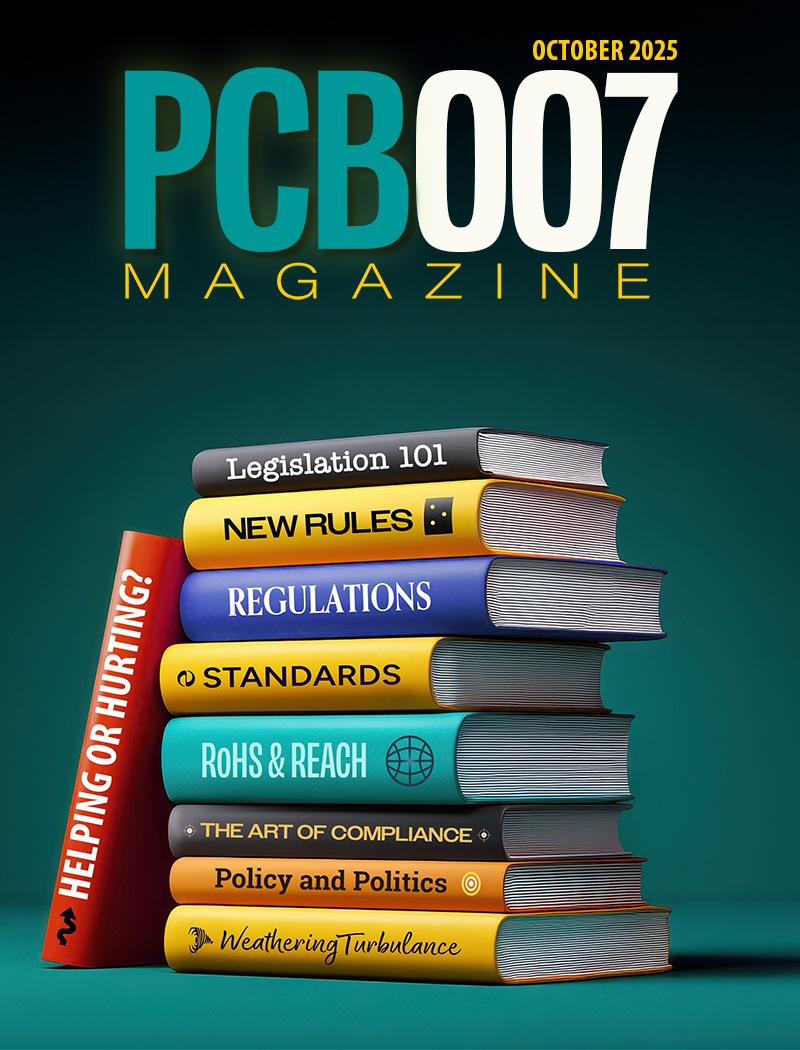-

- News
- Books
Featured Books
- pcb007 Magazine
Latest Issues
Current Issue
The Legislative Outlook: Helping or Hurting?
This month, we examine the rules and laws shaping the current global business landscape and how these factors may open some doors but may also complicate business operations, making profitability more challenging.

Advancing the Advanced Materials Discussion
Moore’s Law is no more, and the advanced material solutions to grapple with this reality are surprising, stunning, and perhaps a bit daunting. Buckle up for a dive into advanced materials and a glimpse into the next chapters of electronics manufacturing.

Inventing the Future With SEL
Two years after launching its state-of-the-art PCB facility, SEL shares lessons in vision, execution, and innovation, plus insights from industry icons and technology leaders shaping the future of PCB fabrication.
- Articles
- Columns
- Links
- Media kit
||| MENU - pcb007 Magazine
U.S. Congress Approves Funds for R&D on Lead-Free Electronics in Aerospace, Defense and High-Performance Applications
December 22, 2020 | IPCEstimated reading time: 1 minute
The U.S. Congress on Monday approved $10 million for research into the issues surrounding lead-free electronics in mission-critical applications.
IPC, the global association of electronics manufacturers, and its allies had called for these funds to be included in the Fiscal 2021 defense appropriations bill. That bill cleared the U.S. House and Senate last night as part of an omnibus legislative package. President Trump is expected to sign it.
Over the last 15 years, the commercial electronics industry has largely phased out its use of lead (Pb) in electronic components and circuit assemblies, driven by government regulations and concerns about lead’s harmful effects on human health and the environment. However, the aerospace, defense and high-performance (ADHP) sectors have been reluctant to migrate to lead-free electronics because there is inadequate data on the reliability of lead-free components in ADHP applications.
The gap between commercial and defense electronics is growing wider as lead-free becomes more established in commercial technologies, and as governments – particularly in Europe – have implemented more stringent rules on the use of lead. Today’s defense electronics are now 15 to 20 years behind the commercial market in terms of the underlying materials used, undermining supply chain resiliency and technological superiority.
“This vote is a win for U.S. taxpayers, defense readiness, and the electronics industry supply chain,” said Chris Mitchell, IPC vice president of global government relations.
“The migration of the commercial industry to lead-free electronics has created supply-chain concerns for the ADHP sectors that can only be overcome through public-private R&D,” he added. “These funds will support a collaborative research effort that will help ensure that mission-critical systems have full access to cutting-edge electronics from a robust global supply chain.”
“Together with our partners in the Pb-Free Electronics Risk Management (PERM) Council, IPC will continue to advocate for a proactive, long-term approach to this issue,” Mitchell added.
IPC President and CEO John Mitchell recently delved into these issues in an article in Defense News titled, “Protecting America’s military prowess requires an embrace of lead-free electronics.”
Industry experts believe a five-year, $40 million investment in a public-private R&D program would yield more than $100 million in U.S. defense savings per year and improve military readiness and overall innovation. The Congress provided $5 million for such R&D in FY 2020.
Testimonial
"The I-Connect007 team is outstanding—kind, responsive, and a true marketing partner. Their design team created fresh, eye-catching ads, and their editorial support polished our content to let our brand shine. Thank you all! "
Sweeney Ng - CEE PCBSuggested Items
SPEA Philippines: Grand Opening Cerimony
11/14/2025 | SPEASPEA proudly inaugurated its new office in the Philippines, marking a significant step in strengthening its presence in the heart of Southeast Asia’s electronics manufacturing hub.
Neways Electronics Celebrates Grand Opening of New Manufacturing Facility in Slovakia
11/14/2025 | NewaysNeways, the global innovator in mission-critical technology for semicon, defense & mobility, and connectivity sectors, is proud to announce the grand opening of a new state-of-the-art manufacturing facility in Nová Dubnica, Slovakia.
Indium Experts to Present on Power Electronics at productronica 2025
11/14/2025 | Indium CorporationAs one of the leading materials providers to the power electronics assembly and e-Mobility industries, Indium Corporation® experts will share their technical insight and knowledge on a variety of industry-related topics during Productronica, November 18-21, in Munich, Germany.
ESCATEC Installs Third Wave Soldering Machine in Penang to Meet Growing Demand
11/14/2025 | ESCATECESCATEC’s business unit in Penang, ESCATEC Electronics Sdn Bhd (EEM), recently welcomed the installation of an advanced Ersa POWERFLOW ULTRA wave soldering system, strengthening its capabilities and production capacity for customers bringing complex high-tech products to market.
Interlink Electronics Reports Q3 2025 Results
11/14/2025 | Globe NewswireInterlink Electronics, Inc., a global leader in sensor technology and printed electronic solutions, reported results for the third quarter ended September 30, 2025.


